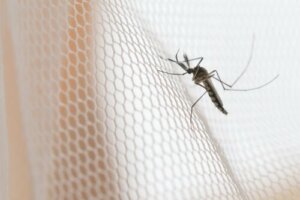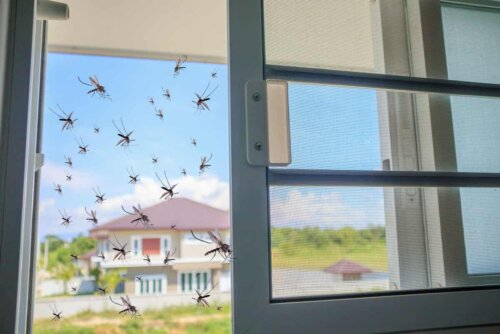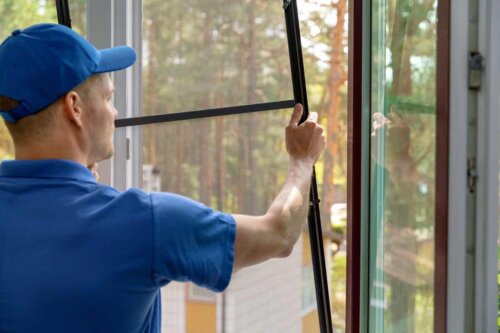Types of Mosquito Screens and Their Characteristics

It’s safer to open your doors and windows during summer after you install mosquito screens at home.
After all, when you open your windows, you tend to let more than air come in when you do: mosquitoes, flies, and other flying invaders. A screen can protect you by keeping them from letting themselves in while you air the rooms.
There are several types of screens and the choice depends on the characteristics that best suit your space. Stick around to learn a little more about this helpful protection!
The characteristics of mosquito screens
These are basically framed nets with tiny, tiny holes. People use them to open doors and windows to ventilate houses without allowing pests to go in. They’re usually made of fiberglass covered with PVC, although manufacturers use many other materials for this purpose.
Mosquito nets help avoid the use of chemical repellents and take advantage of natural air and light. Also, some models are great for keeping pets in.
Find out All About Mosquito Bites
Types of mosquito screens
Long gone are the conical screens that used to hang from the ceiling above the bed. Those our grandparents used for preventing the stings of disease-transmitting bloodsuckers.
Nowadays, the models depend on the area of the house where you want to install them, the decor preferences, and the needs to cover. Here are the most popular ones.

1. Sliding mosquito screens
These are the most commonly installed on exterior doors and windows. The aluminum frame adapts to the frame in which they’ll be installed.
Two lower bearings simplify the sliding of these screens and move along horizontal rails. They’re easy to install. In fact, all you have to do is measure and fit them into your frame.
There are times when the frame tends to distort due to exposure to heat or constant use. As a precaution, adjustable wheels can correct this kind of imperfection.
2. Fixed screens
These are also known as standard and are usually the least expensive. They were originally used on windows, but some exceptions allow them to be placed on exterior access doors. Furthermore, they differ from the rest because they’re permanent.
The screens have frame profiles, corner joints, rubber fasteners, and fiberglass. They’re useful against pollution with the addition of filters. In addition, their appearance is similar to the sliding ones, but without bearings.
As they’re fixed, try to place them in areas where you won’t have to move them. In storage rooms, basements, or garages, for example. All you have to do to install them is press them in and affix them with screws or brackets.
3. Roller mosquito screens
This is perhaps the most sought-after on the market, as you can use them only when you need them. Thus, you can store them during winter.
These mosquito nets roll out, they’re similar to blinds in that regard, and either raise or lower through side frames on the windows. The guides at every end facilitate this because they’re designed to stretch the mesh.
4. Expandable screens
These types of mosquito screens stretch from the bottom to the top along the same rails of the blind. Thus, the blind actually goes up while the net stays down.
5. Curtains
These are mainly for doors and manufactured with the classic mesh, support, and a groove attached to two strips of fabric. The mesh is closed with velcro so that pests don’t pass through.
6. Magnetic or adhesive screens
These types of screens are stick-on, be it with adhesive or with a magnet. They’re for indoor use and easy to install. In addition, there’s no need to unroll or move panels to go through a door.
7. Pleated nets
The accordion shape of this type of mosquito screen facilitates retraction and they hold tightly to one end of the frame. It’s the newest model for windows and doors.
Drawing them is all it takes to retract or extend them, always in the direction of the guides. They’re lightweight and you can fold them into a small space so don’t be put off by their bulky look.
They’re perfect for homes of people who must use wheelchairs or in those where there are baby strollers because there’s no barrier on the threshold.
8. Mosquito screens with velcro
You can use velcro to cover all kinds of gaps and the installation is quite simple. Just cut it to size and glue it to the frame and to the mesh and then join them.
9. Hinged doors
This is a second aluminum door with hinges that open outwards. The installation is based on the coupling to the molding.
10. Custom-made screens
These are made to fit the window and come in handy when the frames aren’t standard. There are specialists who can assemble them, but the stores offer kits with which you can easily make them yourself.
The advantages of mosquito screens
In addition to deterring bugs, mosquito screens offer many advantages:
- Protection. You can open the windows of an apartment without exposing children or pets. This is because screens limit their access to the outside.
- Privacy from the outside as you can’t see through the screens create.
- Energy-saving. Keeping your windows and doors open during the summer will help you skip the AC.
- Health. These screens are great as far as allergies go as they hold on to dust, so there’ll be less cleaning to do.
- Resistance. Screens manufacturers use highly durable materials and are sunlight resistant. Thus, it’s a one-time investment and you don’t have to worry about replacements.

The disadvantages of mosquito screens
In general, the advantages of mosquito screens outweigh the disadvantages. However, there are a couple of them you should consider.
Open or close them, just don’t leave them partly open as it’s the only way to ensure that no bugs will go through. Also, it’s impossible to install them in double windows with small spaces, as they require a minimum area of 1 3/4 inches.
Certification and maintenance of mosquito screens
It’s easier to make a selection when you knowing the characteristics and types of mosquito screens on the market. Thus, don’t buy the first one you find and choose it according to your needs.
Verify that your buying a product made with anti-pollen, anti-mite, and anti-pollution fabrics by asking the salesperson. Also, look for the ECARF certification.
Finally, screens require cleaning. To do so, dampen a rag with soap and water, wipe the screen and then rinse and dry it. This’ll remove any dirt blockages.
Be proactive and adapt your mosquito screens in advance. Don’t let the summer and the annoying mosquitoes that come with it sneak up on you!
All cited sources were thoroughly reviewed by our team to ensure their quality, reliability, currency, and validity. The bibliography of this article was considered reliable and of academic or scientific accuracy.
- Oficina Regional para las Américas de la Organización Panamericana de la Salud. Diez enfermedades transmitidas por vectores que ponen en riesgo a la población de las Américas. OPS. Estados Unidos. https://www.paho.org/hq/index.php?option=com_content&view=article&id=9438:2014-10-vector-borne-diseases-that-put-population-americas-at-risk&Itemid=135&lang=es#:~:text=mediateam%40paho.org-,Diez%20enfermedades%20transmitidas%20por%20vectores%20que%20ponen%20en%20riesgo%20a,el%20virus%20del%20Nilo%20Occidental.
- González L. Alergias y el sistema inmune: una revisión desde el aula. Revista Facultad de Ciencias de la Salud (Udes). Vol 1. Colombia; 2014. https://journalhealthsciences.com/index.php/UDES/article/view/7
This text is provided for informational purposes only and does not replace consultation with a professional. If in doubt, consult your specialist.








